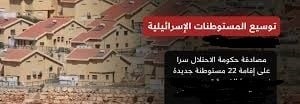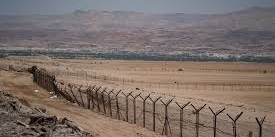By: Madeeha Al-A’raj
The National Bureau for defending land and resisting settlements ( nbprs ) stated in its latest weekly report , that dirty war is taking place in the corridors of the Israel Knesset between the government and the opposition about the extension of the so-called “Judea and Samaria’s Laws, which were approved by the occupying power in 1967 after occupying the West Bank, stipulated the application of Israeli Criminal Law on settlers in the occupied West Bank, and determines the status of settlers on Area C, where the government coalition in Israel failed last week to extend the application of the Israeli civil law to settlers in the West Bank, which is renewed in the Knesset every 5 years, but this time was postponed several times due to the lack of a majority. The gov’t’s failure to pass the laws doesn’t mean it downfalls, as it still has time and chances to vote until the end of this June.
On the other hand, the Bennett’s Gov’t speeds up settlement projects, as it has deposited 6 detailed structural plans to build a total of 1,208 settlement units on an area of 953 dunums in the West Bank in the detailed structural plan n. 25/125 for the Al-Kana Settlement built on Masha village lands in the geographical location known as ‘The Western Face’ on an area of 112 dunums, where the project aims to establish 351 settlement units and public institutions, and the detailed structural plan n. 58 dunums, where the project aims to establish 58 settlement units.
Moreover, the settlement sub-committee has deposited a detailed structural plan no. 10/4/1/117 for the Karni Shamron settlement built on the lands of Deirstiya with the aim of establishing 27 settlement units, as well as the detailed structural plan n. 171/1 for the Rahalim settlement built on the lands of Deir Istiya. Al-Sawiya, Yatma, and Al-Lubban Al-Sharqiya on about 575 dunums, for the construction of 212 settlement units, in addition to a tender n. Ysh 172/2022 in the Karni Shomron settlement to establish commercial areas within the structural plan n. 117/18.
At the same time, the occupation forces notified to seize more than 600 dunams in the Tarqumia town, northwest of Hebron. They handed notices to a number of citizens to vacate their lands planted with olive trees and vines, in the Al-Taybeh area known as Al-Harash under the pretext that it is “state property. Even though the owners confirmed that they have proofs of ownership of the lands, stressing that the goal of the occupation is to seize it, to expand the ‘Telem and Adora’ settlements.
In Jerusalem, the ‘Israeli Regional Council for Building and Settlement’ revealed that a series of projects in accordance to the Israeli concept of ‘Greater Jerusalem’ have been re-launched, especially in the areas adjacent to Jerusalem. The sub-committee on settlements in the military government – the Civil Administration – submitted a detailed master plan for one of the largest settlements to be built on the lands of Al-Walaja and Battir, south of Jerusalem, on the lands of the Bethlehem Governorate. The detailed structural plan of the settlement was deposited under the name Givat Bael. According to the plans, 5,000 settlement units will be built on the lands of the villages of Al Walaja and Battir on 520 dunums, which will completely isolate the Walaja village, so getting in and out f the village will be through a Military Gate.
The plan in general will confiscate an area of 2,000 dunams located within the municipal boundaries of Jerusalem. And the remaining 24,000 dunums is located outside the artificial boundaries of the municipality. According to the Civil Administration, the goal of the new settlement “Givat Ba’el” is to create a settlement continuity that erases the Green Line, and draws a new line ‘the Greater Jerusalem Plan’ according to the Israeli concept, which is to enlarging and expanding the borders of Jerusalem and the municipality, and expanding the area of administrative control in the Gush Etzion settlement bloc that includes the illegal Israeli settlements in Nekodim Tikoa, Kafr Eldad, Ma’aleh Amos, Asfar Masad and Abi Nahal in the Gush Etzion West settlement bloc by allocating special areas for future expansion at the expense of the surrounding Palestinian lands.
As for the Israelization of education in Jerusalem, the Finance Committee of the occupation municipality in Jerusalem allocated a budget of NIS 514,000,000 to strengthen its presence in the education sector in East Jerusalem, it includes 18 projects to build classrooms and kindergartens in the villages and neighborhoods of the city. The total budgets of NIS 310,000,000 were approved to build classrooms, schools, including 4 kindergartens in Sheikh Jarrah Neighborhoods, 6 kindergartens in Umm Tuba, a wing in a village school, and 18 primary classrooms.
Besides, approving budgets of NIS 275,000,000 for the infrastructure of light rail, in addition to allocating NIS 33,000,000 to develop roads and work in Area C in the West Bank to expand the Northeast Jerusalem Hizma Street and the military crossing. A budget of NIS 10,000,000 was also approved for parts of Road 437 from the northern entrance to the village of Hizma to the entrance to the settlement of “Sha’ar Binyamin’ near Jaba, as well as NIS 402,000,000 in Wadi al-Joz, Jabal al-Mukabber, Wadi al-Qudum, and the Welfare Office in Beit Hanina, and NIS 2,000,000 was approved to for the traffic light in al-Tur and al-Sawana, in Wadi al-Joz and in Sheikh Jarrah, and to expand the streets there.
List of Israeli Assaults over the Last Week Documented by the National Bureau:
Jerusalem:
- The Israeli Supreme Court has given the green light to the Ateret Cohanim Settlement Association to seize properties of the Greek Orthodox Patriarchate in occupied East Jerusalem
- Disclosing serious details about the intention of the occupation authorities to deduct an area of Al-Aqsa Mosque for the benefit of the settlers, and to prevent Muslims from accessing it, as the Likud party approved the project to establish a synagogue there.
- Storming a residential building in the Wadi Qaddoum Neighborhood in the Silwan town, south of the Al-Aqsa Mosque, warning its residents to evacuate in preparation for its demolition, under the pretext of building without a permit.
Hebron:
- Forcing citizen, Murad Hamamdeh to demolish part of his home in Masafer Yatta, south of Hebron, and other citizens to leave their lands in the Al-Ain Al-Bayda area, and 8 wells to collect drinking water and a sheep pen, in the village of Al-Tabban, south of Hebron.
- Building a settlement road in the “Al Martaba area, east of Yatta, and destroyed the monument of the martyr Sheikh Suleiman Al-Hathlin, which was erected by the families of Al-Musafer and a number of foreign activists and solidarity activists near the entrance to the village of Um Al-Khair, east of Yatta, for his role in confronting the occupation and its settlement projects, being a symbol of popular resistance in the area.
Bethlehem:
- Attacking a number of houses in the village of Al Jabaa, west of Bethlehem, threw stones and paint bottles, attacked citzen Raja Abayat, while he was on his land.
- Demolishing a house under construction in Beit Jala, Bir O’una, under the pretext of building without a permit
Ramalah:
- Injuring a child when a group of settlers attacked him in the Al-Nabi Saleh village, west of Ramallah.
Nablus:
- Preventing citizens from reclaiming their lands south of Nablus in the southern region of Qusra town on the pretext that it is Area C, knowing that it is B under the Oslos Accord.
- Torching a wheat crop in the lands of the Qusra town, south of Nablus.
Tulkarm:
- Demolishing an underground water-well near the main street in the Beit Lid town, knowing that the well is for drinking and serves the entire population of the town.
 المكتب الوطني للدفاع عن الارض ومقاومة الاستيطان منظمة التحرير الفلسطينية
المكتب الوطني للدفاع عن الارض ومقاومة الاستيطان منظمة التحرير الفلسطينية




